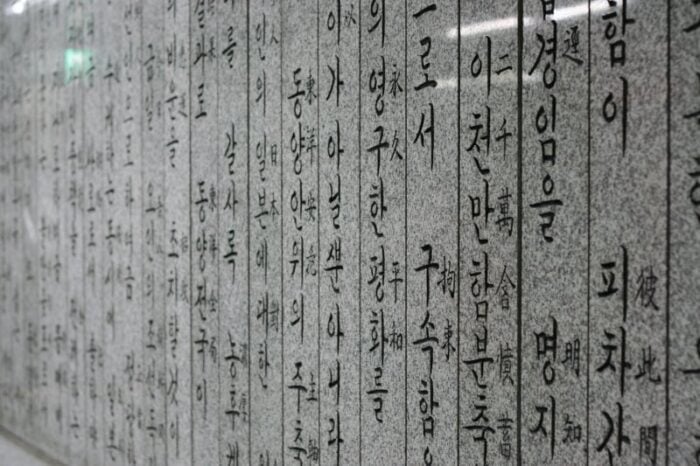Korean Letters: A Guide to the Korean Alphabet
Hangul: The Korean Alphabet
Hangul consist of 24 basic Korean letters: 14 consonants and 10 vowel sounds. There are also 16 additional complex symbols: 5 tense consonants and 11 complex vowels, which result from combining the basic letters. Drawing the Korean alphabet is not as difficult as it may seem, as the most intricate character only has five strokes.
Bang, burp, splash, flash, click, cuckoo. What do these words have in common? Clue: you might have to say them aloud to figure out the answer.
These words –a very small group within the English vocabulary– are imitative of sound, i.e., they echo the sound associated with the object or action they refer to. How easy it would be to learn a language if all words were echoic, right?
Believe it or not, learning Korean letters is easier than you might think for similar reasons. Although the language per se is quite complex, its brilliant alphabet has characters that mimic the shape of the articulating organs involved in their pronunciation.
Unsurprisingly, the Korean alphabet (Hangul) is a perfect phonetic system designed to defy the tests of time and usage.
Whether you want to learn Korean letters because you’re travelling to Seoul, you want to learn Korean with K-Pop, or simply a Korean culture enthusiast, memorising the characters of Hangul is the right place to start. As you realise how simple it really is, you will gain the confidence to keep on learning, and you will soon be able to read most texts in Korean.
So, forget about tricks and shortcuts such as Romanisation and grab a pen and a piece of paper because today we are teaching you everything you need to know about Korean letters.
Table of Contents
The Origins of Korean Letters: How Was Hangul Created?
Reading about the history of an alphabet might sound like a dull affair, but this is not the case when it comes to Hangul. Before its creation in the fifteenth century, Koreans wrote the words of their language using Chinese symbols, which they mixed with other native characters. Plus, a huge part of the country’s population couldn’t read or write.
The differences between Korean and Chinese were just too big and complicated. Thus, in an effort to encourage literacy, King Sejong the Great developed a new, simpler, and unifying spelling system which he called Hangul. A document written in 1446, but discovered almost 500 years later, explains that the shape of Korean letters mirrors a person’s lips, whereas vowel symbols are inspired by the principles of harmony and yin and yang.
This new writing system served one goal: that uneducated people could learn how to read and spell.
An Overview of the Korean Alphabet
As we said before, Hangul consists of 24 basic Korean letters: 14 consonants (ㄱ ㄴ ㄷ ㄹ ㅁ ㅂ ㅅ ㅇ ㅈ ㅊ ㅋ ㅌ ㅍ ㅎ) and 10 vowel sounds (ㅏ ㅑ ㅓ ㅕ ㅗ ㅛ ㅜ ㅠ ㅡ ㅣ). Besides, as you delve deeper into it, you’ll soon find out that the Korean alphabet has 16 additional complex symbols: 5 tense consonants (ㄲ ㄸ ㅃ ㅉ ㅆ) and 11 complex vowels (ㅢ ㅚ ㅐ ㅟ ㅔ ㅒ ㅖ ㅘ ㅝ ㅙ ㅞ) which result from combining the basic letters.
Unlike languages like Japanese, which have hundreds of symbols (each one of them made up of up to 20 strokes), the most intricate Korean character only has five. What’s more, Hangul is very methodic. Once you manage to understand its logic, the learning process becomes much smoother.
Korean letters are known as jamo (자모) and they consist of syllabic blocks laid out in two dimensions. One such block always has exactly one syllable. For example, if you want to spell “honeybee” in Korean (two syllables: kkulbeol), you have to write 꿀벌, not ㄲㅜㄹㅂㅓㄹ. Another thing you need to take into account is that Korean script is typically arranged from left to right with spaces between.
How to Pronounce Korean Consonants
Since this is a blog and not a podcast, it would be very difficult for us to explain what Korean consonants sound like. After all, languages from different linguistic families are so different that there are very few one-to-one equivalents across their phonetic systems.
Anyway, here’s a basic chart with all the consonants in Hangul that will give you an approximate idea of how to pronounce these sounds.
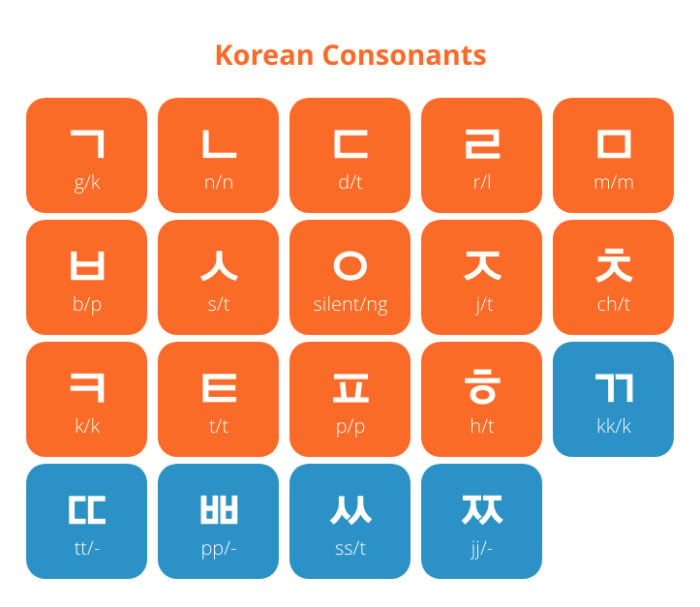
Notice that the complex or double consonants on the last row of the chart are in a different colour. Under each character, you’ll find its approximate phonetic equivalent at the onset and at the coda of the syllable. Take “ㅇ”, for example, which is silent at the beginning of syllables but serves as a placeholder when the syllable begins with a vowel sound.
It may sound like a lot of information at first, but with study and dedication, you will master Korean letters in just a few weeks. All you need to do is look for acoustic references (in music, film, and podcasts) to match all these rules. Our article with catchy Korean songs to help you practice the Korean alphabet will surely prove useful!
As with any language, listening to the Korean letters in context is the best thing you can do to incorporate the beautiful sounds of the language.
Korean Vowels and Their Pronunciation
Korean vowels fall into two categories depending on how many articular movements they require. Sounds that consist of only one element are monophthongs, whereas vowels with two sounds are diphthongs.
The good news about Korean vowels is that they always have the same sound, no matter what position they have in the syllable.
Here is a chart that will tell you how to pronounce Korean vowel sounds.
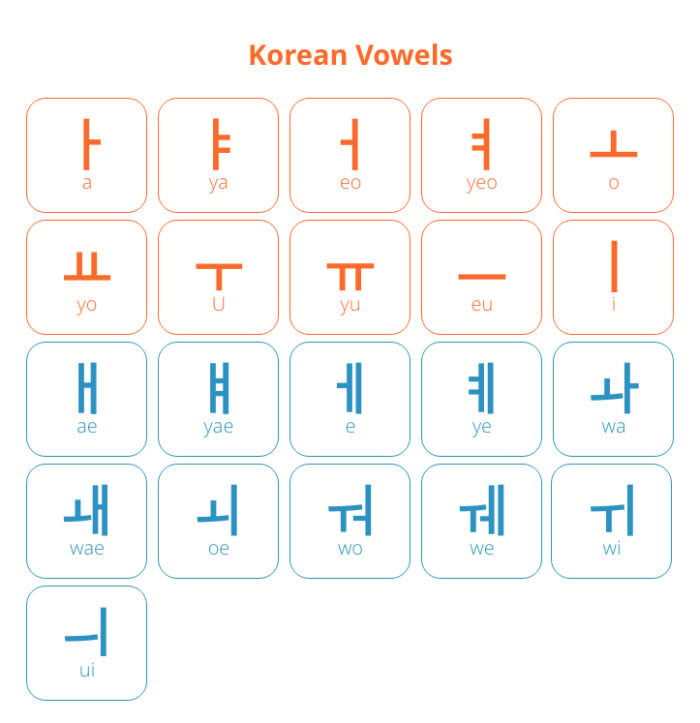
The characters represented in blue in the last two rows are the eleven compound sounds that combine basic vowels.
Do Korean Letters Have Names?
The order of the alphabet in Korean differs from that in English in an essential aspect. Whereas the English ABC mixes consonants and vowels, Hangul lists consonants first and then all the vowels.
Now, if you’re a beginner learner, you will need to learn not only the prounciation of Korean letters, but also their names. That way, if you don’t remember how to pronounce a word, you can spell it out by saying the name of the Korean letters. (However, be careful not to overuse this technique and only employ it as a last resource!)
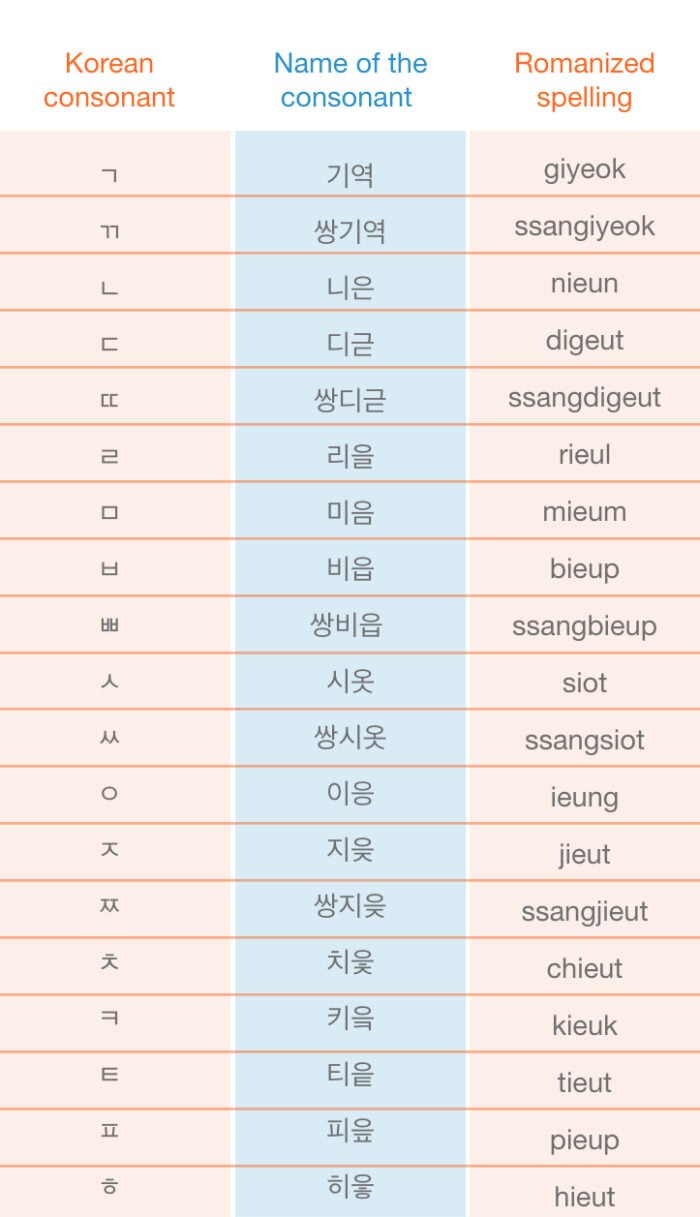
As you might have noticed, the table includes both simple and complex consonants. So, now let’s focus on vowels. Feeling overwhelmed already? Don’t worry. Since the vowels’ names mirror the sounds they make, this bit will be easy.
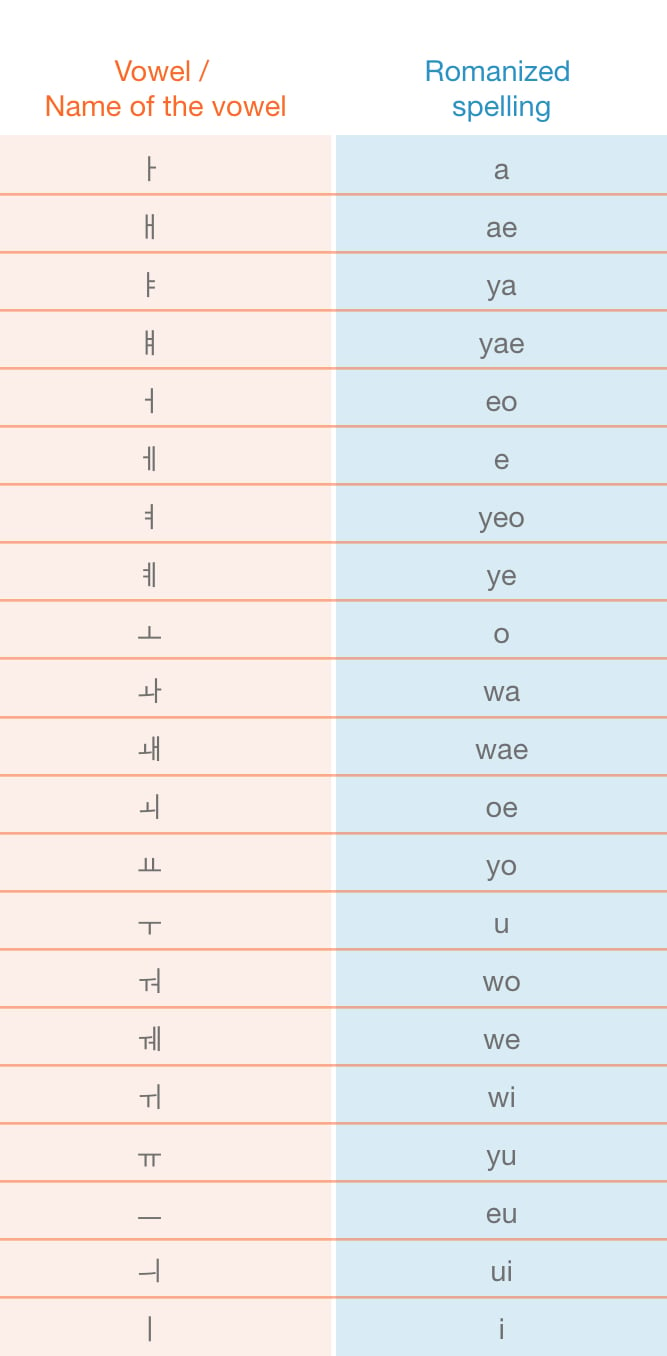
Beyond Korean Letters: Learn Korean Now
As you can see, learning how to use Korean letters is not as hard as it seems. With a little (okay, a lot of!) study and motivation, and above all, lots of exposure to spoken Korean, you will get there faster than you might have thought.
Have you mastered Hangul already? Are you ready to start working on your fluency? With our tailor-made courses taught by native teachers, you will master Korean pronunciation much faster than with traditional courses.
We offer fast, entertaining, and highly efficient learning methods that favour natural learning through interesting topics, authentic interaction, and lots of speaking. What are you waiting for? Explore our Korean courses now or send us a message! Additionally, you can test a free level test to see what your current skills are.
This article was updated on June 27, 2023

